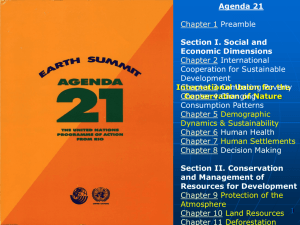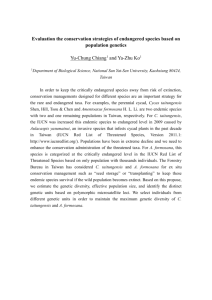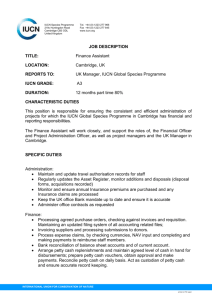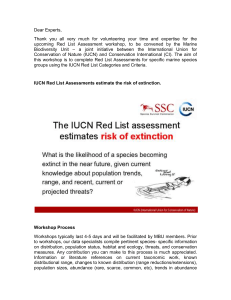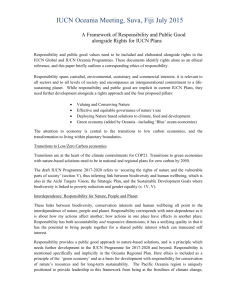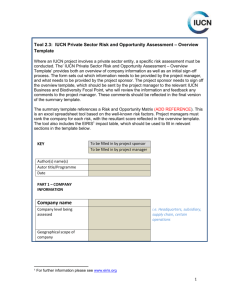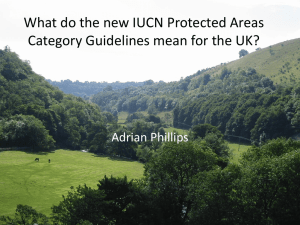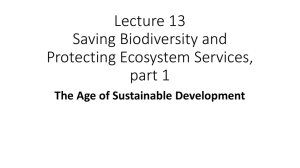The IUCN Red List Criteria
advertisement
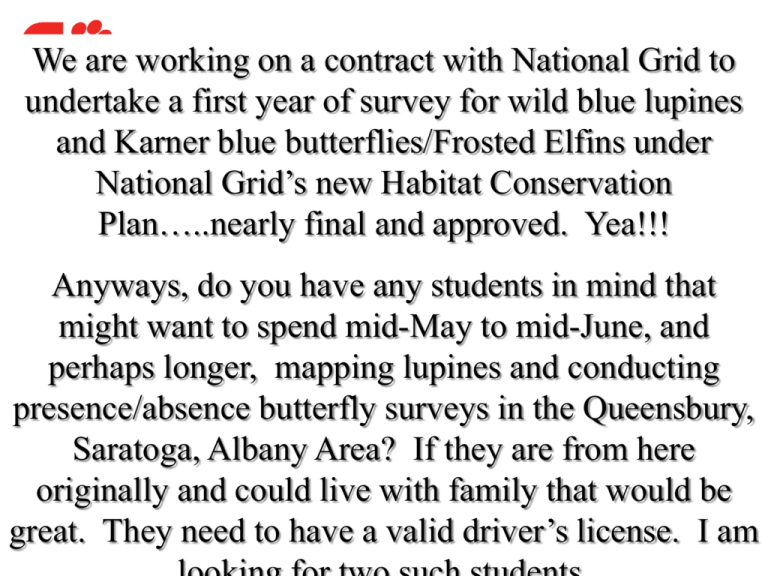
We are working on a contract with National Grid to undertake a first year of survey for wild blue lupines and Karner blue butterflies/Frosted Elfins under National Grid’s new Habitat Conservation Plan…..nearly final and approved. Yea!!! Anyways, do you have any students in mind that might want to spend mid-May to mid-June, and perhaps longer, mapping lupines and conducting presence/absence butterfly surveys in the Queensbury, Saratoga, Albany Area? If they are from here originally and could live with family that would be IUCN (International Union for Conservation of Nature) great. They need to have a valid driver’s license. I am NYSDEC Division of Fish, Wildlife and Marine Resources: 42 paid internships available for SUNY-ESF Students! The New York State Department of Environmental Conservation’s Division of Fish, Wildlife and Marine Resources has just added 16 more paid internships to the 26 already available for the 2012 season for SUNY-ESF students. The following 42 internship opportunities are now available for the spring/summer season: www.esf.edu/efb/gibbs/NYSDEC_2012.htm New internships are highlighted in gray. If you have already applied you may reapply for the new ones. No internships have yet been filled. Many internships now have detailed descriptions. Currently enrolled students can work for up to 20 weeks and up to 800 hours. Students must be enrolled in fall semester 2012 to be eligible. Pay rate is $10/hr for undergraduates and $15/hr for graduate students. If you are interested in applying for any of these positions, please send as a single document .pdf attachment to an email to jpgibbs@esf.edu : – a short cover letter that identifies the specific internship(s) you wish to be considered for (please identify position number) and outlines your qualifications and interest in each – includes a resume with your contact information (email and phone). IUCN (International Union for Conservation of Nature) IUCN “Redlist” exercise • Review an outdated listing for an endangered species (to be announced at start of next class) • Understand how the classification process works by working through a case study IUCN (International Union for Conservation of Nature) Overview of the IUCN Red List Unit Cambridge, UK IUCN (International Union for Conservation of Nature) International Union for Conservation of Nature (IUCN) IUCN Members 80 States Commissions (10,000 scientists & experts) 112 Government agencies >800 NGOs IUCN Secretariat 1,100 staff in 62 countries, led by IUCN’s Director General (Julia Marton-Lefevre) IUCN (International Union for Conservation of Nature) IUCN Red List Unit • Management of the IUCN Red List (database, web site) • Assessment review • Petitions and enquiries • Training workshops • Assessment workshops • Other projects and Red List tools ̶ Red List Index ̶ Global Species Assessments ̶ Regional assessment initiatives ̶ Climate change and extinction risk assessment IUCN (International Union for Conservation of Nature) 2000 2009 IUCN (International Union for Conservation of Nature) What are we trying to do? • Identify and document those species most in need of conservation attention if the global extinction rates are to be reduced. • Provide a global index to monitor the status of the world’s biodiversity. IUCN (International Union for Conservation of Nature) The IUCN Red List Assessment: An estimate of extinction risk What is the likelihood of a species Becoming extinct in the near future, given current knowledge about population trends, range, and recent, current or projected threats? IUCN (International Union for Conservation of Nature) Illustration copyright Bob Diven IUCN Red List Categories & Criteria Also refer to: Guidelines for Using the IUCN Red List Categories and Criteria: version 7.0 (August 2008) Free download from the IUCN Species Survival Commission web site (www.iucn.org/themes/ssc) or the Red List web site (www.iucnredlist.org). Version 2.3 3.1 (1994) (2001) IUCN (International Union for Conservation of Nature) Terrestrial biodiversity (6,260) (9,990) (5,488) (910) IUCN (International Union for Conservation of Nature) Marine biodiversity IUCN (International Union for Conservation of Nature) Polidoro et al. Freshwater biodiversity Darwall et al. IUCN (International Union for Conservation of Nature) The Past: IUCN (International Union for Conservation of Nature) Introduction to the IUCN Red Listing Process IUCN (International Union for Conservation of Nature) The IUCN Red List Categories & Criteria All materials are freely available on IUCN Red List web site: www.iucnredlist.org IUCN (International Union for Conservation of Nature) Rabb’s Fringe-limbed Treefrog Ecnomiohyla rabborum Category: Critically Endangered CR A2ace;B1ab(iii) Criteria & subcriteria IUCN (International Union for Conservation of Nature) The IUCN Categories Extinct (EX) Extinct in the Wild (EW) Critically Endangered (CR) Endangered (EN) Vulnerable (VU) Near Threatened (NT) Least Concern (LC) Data Deficient (DD) Not Evaluated (NE) IUCN (International Union for Conservation of Nature) Extinct (EX) A taxon is Extinct when there is no reasonable doubt that the last individual has died. Extinct in the Wild (EW) Dodo, Raphus cucullatus A taxon is Extinct in the Wild when it is known only to survive in cultivation, in captivity or as a naturalized population (or populations) well outside the past range. IUCN (International Union for Conservation of Nature) Photo © Craig Hilton-Taylor Franklinia, Franklinia alatamaha A taxon is threatened when the best available evidence indicates that it meets any of the criteria A to E for the thresholds stated in one of the three threatened categories: Critically Endangered, Endangered or Vulnerable. Critically Endangered (CR) CR taxa are considered to be facing an extremely high risk of extinction in the wild Photo © Wendy Strahm Endangered (EN) Mandrinette, Hibiscus fragilis EN taxa are considered to be facing a very high risk of extinction in the wild Black-browed Albatross, Thalassarche melanophrys Photo © Tony Palliser Vulnerable (VU) Golden Pagoda, VU taxa are considered to be facing a high risk of IUCN (International Union for Conservation Mimetes of Nature) extinction in the wild chrysanthus Photo © Craig HiltonTaylor Near Threatened (NT) A taxon is Near Threatened when it has been evaluated against the criteria and does not qualify for CR, EN or VU now, but is close to qualifying for or is likely to qualify for a threatened category in the near future. Photo © H. Fraga Macaronesian Laurel, Laurus azorica Least Concern (LC) A taxon is Least Concern when it has been evaluated against the criteria and does not qualify for CR, EN, VU or NT. Widespread and abundant taxa are included in this category. IUCN (International Union for Conservation of Nature) Photo © Caroline Pollock Olive Baboon, Papio anumbis Data Deficient (DD) A taxon is Data Deficient when there is inadequate information to make a direct, or indirect, assessment of its risk of extinction based on its distribution and/or population status. Tree Tomato Solanum [Cyphomandra] betacea Not Evaluated (NE) A taxon is Not Evaluated when it has not yet been evaluated against the criteria IUCN (International Union for Conservation of Nature) The IUCN Red List Criteria IUCN (International Union for Conservation of Nature) Nature of the Criteria THREATENED CATEGORIES CRITERIA A Population reduction B Restricted geographic range C Small population size & decline D Very small or restricted population E Quantitative analysis Critically Endangered (CR) Quantitative thresholds Endangered (EN) Vulnerable (VU) IUCN (International Union for Conservation of Nature) Why use multiple criteria? Not all the criteria are appropriate to all taxa. • • • All taxa being assessed must be evaluated against each criterion. Meeting any one of the criteria qualifies a taxon for listing at that level of threat All criteria met at the highest level of threat should be listed. IUCN (International Union for Conservation of Nature) Criterion A Past, present or future population reduction Population Size Time IUCN (International Union for Conservation of Nature) Criterion A Based on any of four criteria: A1: Population reduction in past and causes of decline now ceased A2: Population reduction in past and causes of decline ongoing A3: Population reduction expected in future A4: Population reduction in past AND future IUCN (International Union for Conservation of Nature) Criterion B Restricted geographic range and fragmentation, continuing decline or extreme fluctuations IUCN (International Union for Conservation of Nature) Criterion B Based on either of two sub-criteria: B1: Estimated extent of occurrence AND / OR B2: Estimated area of occupancy AND at least TWO of a-c: a. Severely fragmented or few locations b. Continuing decline c. Extreme fluctuations IUCN (International Union for Conservation of Nature) Criterion B Subcriterion B1 Subcriterion B2 Extent of occurrence estimated to be: Area of occupancy estimated to be: CR < 100 km² < 10 km² EN < 5,000 km² < 500 km² VU < 20,000 km² < 2,000 km² IUCN (International Union for Conservation of Nature) Criterion B AND at least TWO of a, b or c: a. Severely fragmented or # locations: CR EN VU 1 5 10 b. Continuing decline in any of the following: c. Extreme fluctuation in any of the following: (i) EOO (i) EOO (ii) AOO (ii) AOO (iii)Area, extent and/or quality of habitat (iii) # locations or subpopulations (iv) # locations or subpopulations (iv) # mature individuals (v) # mature individuals IUCN (International Union for Conservation of Nature) Criterion C Small population size and continuing decline IUCN (International Union for Conservation of Nature) Criterion C Based on small population size AND either C1 or C2: C1: Continuing decline in population size at a specified rate OR C2: Continuing decline in population size at any, unspecified rate AND either C2a or C2b: C2a: (i) very small subpopulations, OR (ii) most mature individuals are in one subpopulation C2b: extreme fluctuations in number of mature individuals IUCN (International Union for Conservation of Nature) Criterion C Thresholds for criterion C Population size is estimated at: CR < 250 mature individuals EN < 2,500 mature individuals VU < 10,000 mature individuals IUCN (International Union for Conservation of Nature) Criterion C Subcriterion C1 Estimated continuing decline of: CR 25% within 3 years or 1 generation EN 20% within 5 years or 2 generations VU 10% within 10 years or 3 generations IUCN (International Union for Conservation of Nature) Criterion C Subcriterion C2 Observed, projected or inferred continuing decline at any rate AND at least one of the following: CR C2a(i). C2a(ii). All subpopulations have: One subpopulation contains: < 50 mature individuals EN < 250 mature individuals VU < 1,000 mature individuals 90% of the mature individuals C2b. 95% of the mature individuals There are extreme fluctuations in number of mature individuals. 100% of the mature IUCN (International Union for Conservation of Nature) individuals Criterion D Very small or restricted population IUCN (International Union for Conservation of Nature) Criterion D Criterion D is split into D for the CR and EN categories; and D1 and D2 for the VU category. D. Total current population size estimated as: CR < 50 mature individuals EN < 250 mature individuals NOTE: for the VU D2, there should be a plausible threat that is likely to rapidly affect the population. D1. Total current population size estimated as: VU D2. The population has a very restricted AOO (typically <20 km²) or is known from very few locations < 1,000 mature IUCN (International Union for Conservation of Nature) (typically ≤5). individuals Criterion E Quantitative analysis = oh ohh! IUCN (International Union for Conservation of Nature) Criterion E Based on quantitative analysis showing a probability of extinction in the wild is at least: 50% 20% Critically Endangered Within 10 years or 3 generations Endangered Within 20 years or 5 generations 10% Vulnerable Within 100 years Up to a maximum of 100 years in the future IUCN (International Union for Conservation of Nature)
